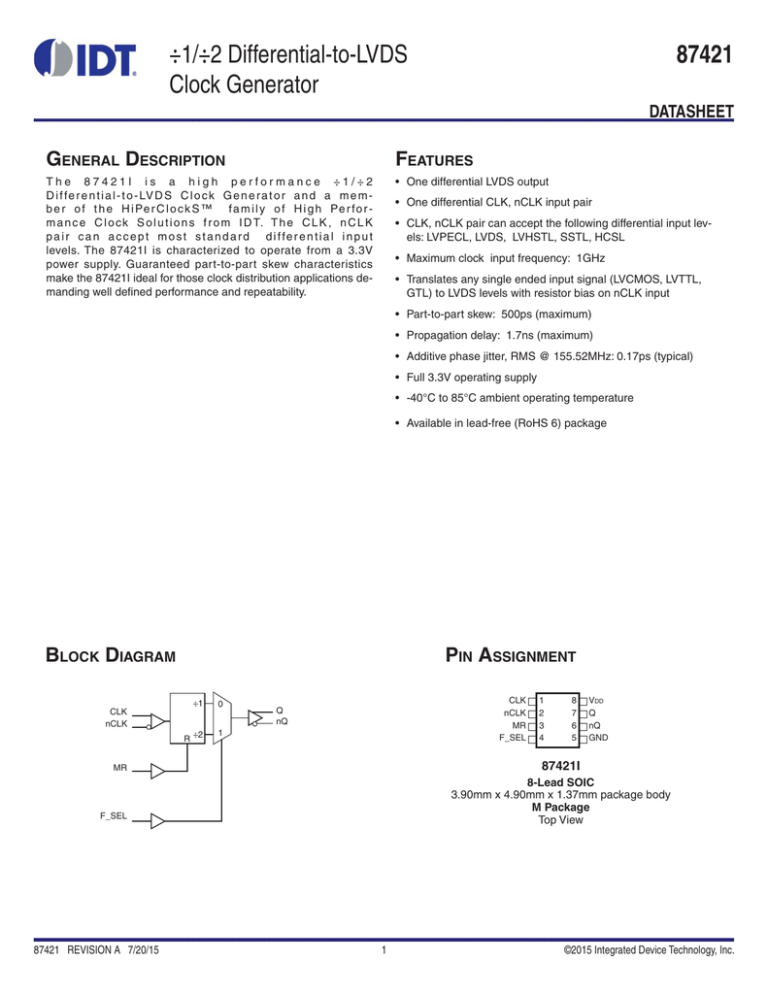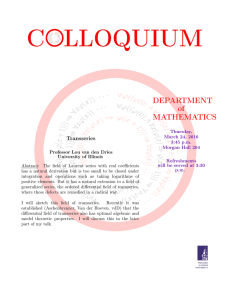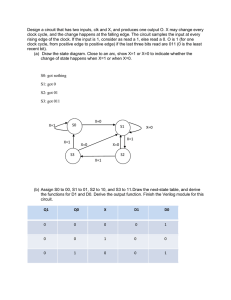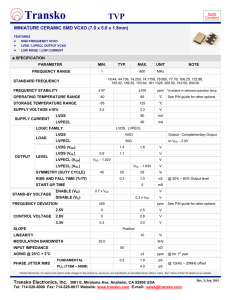
87421
÷1/÷2 Differential-to-LVDS
Clock Generator
DATASHEET
GENERAL DESCRIPTION
FEATURES
The 87421I is a high performance ÷1/÷2
D i f fe r e n t i a l - t o - LV D S C l o c k G e n e r a t o r a n d a m e m b e r o f t h e H i Pe r C l o c k S ™ fa m i l y o f H i g h Pe r fo r m a n c e C l o c k S o l u t i o n s f r o m I D T. T h e C L K , n C L K
p a i r c a n a c c e p t m o s t s t a n d a r d d i f fe r e n t i a l i n p u t
levels. The 87421I is characterized to operate from a 3.3V
power supply. Guaranteed part-to-part skew characteristics
make the 87421I ideal for those clock distribution applications demanding well defined performance and repeatability.
• One differential LVDS output
• One differential CLK, nCLK input pair
• CLK, nCLK pair can accept the following differential input levels: LVPECL, LVDS, LVHSTL, SSTL, HCSL
• Maximum clock input frequency: 1GHz
• Translates any single ended input signal (LVCMOS, LVTTL,
GTL) to LVDS levels with resistor bias on nCLK input
• Part-to-part skew: 500ps (maximum)
• Propagation delay: 1.7ns (maximum)
• Additive phase jitter, RMS @ 155.52MHz: 0.17ps (typical)
• Full 3.3V operating supply
• -40°C to 85°C ambient operating temperature
• Available in lead-free (RoHS 6) package
BLOCK DIAGRAM
PIN ASSIGNMENT
÷1
0
R ÷2
1
CLK
nCLK
CLK
nCLK
MR
F_SEL
Q
nQ
8
7
6
5
VDD
Q
nQ
GND
87421I
MR
8-Lead SOIC
3.90mm x 4.90mm x 1.37mm package body
M Package
Top View
F_SEL
87421 REVISION A 7/20/15
1
2
3
4
1
©2015 Integrated Device Technology, Inc.
87421 DATA SHEET
TABLE 1. PIN DESCRIPTIONS
Number
Name
Type
1
CLK
Input
2
nCLK
Input
Description
Pulldown Non-inverting differential clock input.
Pullup
Inverting differential clock input.
Active High Master Reset. When logic HIGH, the internal dividers are
reset causing the true output (Q) to go low and the inverted output (nQ)
Pulldown
to go high. When logic LOW, the internal dividers and the output are
enabled. LVCMOS / LVTTL interface levels. See Table 3.
Selects divider value for Q, nQ outputs as described in Table 3.
Pulldown
LVCMOS / LVTTL interface levels.
3
MR
Input
4
F_SEL
Input
5
GND
Power
6, 7
Q, nQ
Output
Differential output pair. LVDS interface levels.
8
V
Power
Positive supply pin.
DD
Power supply ground.
NOTE: Pullup and Pulldown refer to internal input resistors. See Table 2, Pin Characteristics, for typical values.
TABLE 2. PIN CHARACTERISTICS
Symbol
Parameter
Test Conditions
Minimum
Typical
Maximum
Units
CIN
Input Capacitance
4
pF
RPULLUP
Input Pullup Resistor
51
kΩ
RPULLDOWN
Input Pulldown Resistor
51
kΩ
TABLE 3. FUNCTION TABLE
MR
F_SEL
Divide Value
1
X
Reset: Q output low, nQ output high
0
0
÷1
0
1
÷2
CLK
MR
Q
FIGURE 1A. ÷1 CONFIGURATION TIMING DIAGRAM
FIGURE 1B. ÷2 CONFIGURATION TIMING DIAGRAM
÷1/÷2 DIFFERENTIAL-TO-LVDS
CLOCK GENERATOR
2
REVISION A 7/20/15
87421 DATA SHEET
ABSOLUTE MAXIMUM RATINGS
Supply Voltage, VDD
4.6V
Inputs, VI
-0.5V to VDD + 0.5 V
Outputs, IO
Continuous Current
Surge Current
10mA
15mA
Package Thermal Impedance, θJA
96°C/W (0 mps)
Storage Temperature, TSTG
-65°C to 150°C
N OT E : S t r e s s e s b eyo n d t h o s e l i s t e d u n d e r A b s o l u t e
Maximum Ratings may cause permanent damage to the
device. These ratings are stress specifications only. Functional
operation of product at these conditions or any conditions beyond
those listed in the DC Characteristics or AC Characteristics is not
implied. Exposure to absolute maximum rating conditions for extended periods may affect product reliability.
TABLE 4A. POWER SUPPLY DC CHARACTERISTICS, VDD = 3.3V±5%, TA = -40°C TO 85°C
Symbol
Parameter
Test Conditions
VDD
Positive Supply Voltage
IDD
Power Supply Current
Minimum
Typical
Maximum
3.135
3.3
3.465
55
Units
V
mA
TABLE 4B. LVCMOS/LVTTL DC CHARACTERISTICS, VDD = 3.3V±5%, TA = -40°C TO 85°C
Symbol
Parameter
Maximum
Units
VIH
Input High Voltage
Test Conditions
Minimum
1.37
Typical
VDD + 0.3
V
VIL
Input Low Voltage
-0.3
0.7
V
IIH
Input High Current
MR, F_SEL
VDD = VIN = 3.465V
150
µA
IIL
Input Low Current
MR, F_SEL
VDD = 3.465V, VIN = 0V
-5
µA
TABLE 4C. DIFFERENTIAL DC CHARACTERISTICS, VDD = 3.3V±5%, TA = -40°C TO 85°C
Symbol
Parameter
Test Conditions
IIH
Input High Current
IIL
Input Low Current
VPP
Peak-to-Peak Input Voltage
VCMR
Common Mode Input Voltage;
NOTE 1
Minimum
Typical
Maximum
CLK
VDD = VIN = 3.465V
150
µA
nCLK
VDD = VIN = 3.465V
5
µA
CLK
VDD = 3.465V, VIN = 0V
-5
nCLK
VDD= 3.465V, VIN = 0V
-150
µA
µA
0.15
1.3
V
GND + 0.5
VDD - 0.85
V
NOTE 1: Common mode voltage is defined as VIH.
REVISION A 7/20/15
Units
3
÷1/÷2 DIFFERENTIAL-TO-LVDS
CLOCK GENERATOR
87421 DATA SHEET
TABLE 4D. LVDS DC CHARACTERISTICS, VDD = 3.3V±5%, TA = -40°C TO 85°C
Symbol
Parameter
VOD
Differential Output Voltage
Test Conditions
Δ VOD
VOD Magnitude Change
VOS
Offset Voltage
Δ VOS
VOS Magnitude Change
Minimum
Typical
Maximum
Units
350
470
540
mV
50
mV
1.1
1.25
1.4
V
50
mV
Maximum
Units
1
GHz
1.7
ns
500
ps
TABLE 5. AC CHARACTERISTICS, VDD = 3.3V±5%, TA = -40°C TO 85°C
Symbol
Parameter
Test Conditions
fCLK
Clock Input Frequency
tPD
Propagation Delay;
NOTE 1
tsk(pp)
Part-to-Part Skew; NOTE 2, 3
tJIT
Additive Phase Noise, RMS;
refer to Additive Phase Jitter Section
tR / tF
Output Rise/Fall Time
20% to 80%
150
500
ps
odc
Output Duty Cycle
fIN < 500MHz
43
57
%
CLK to Q (Dif)
Minimum
Typical
1.0
155.52MHz, Integration Range:
12kHz – 20MHz
0.17
ps
NOTE 1: Measured from the differential input crossing point to the differential output crossing point.
NOTE 2: Defined as skew between outputs on different devices operating at the same supply voltages
and with equal load conditions. Using the same type of inputs on each device, the outputs are measured
at the differential cross points.
NOTE 3: This parameter is defined in accordance with JEDEC Standard 65.
÷1/÷2 DIFFERENTIAL-TO-LVDS
CLOCK GENERATOR
4
REVISION A 7/20/15
87421 DATA SHEET
ADDITIVE PHASE JITTER
(dBm) or a ratio of the power in the 1Hz band to the power in the
fundamental. When the required offset is specified, the phase noise
is called a dBc value, which simply means dBm at a specified offset
from the fundamental. By investigating jitter in the frequency domain,
we get a better understanding of its effects on the desired application
over the entire time record of the signal. It is mathematically possible
to calculate an expected bit error rate given a phase noise plot.
The spectral purity in a band at a specific offset from the fundamental
compared to the power of the fundamental is called the dBc Phase
Noise. This value is normally expressed using a Phase noise plot
and is most often the specified plot in many applications. Phase
noise is defined as the ratio of the noise power present in a 1Hz
band at a specified offset from the fundamental frequency to the
power value of the fundamental. This ratio is expressed in decibels
SSB PHASE NOISE dBc/HZ
Additive Phase Jitter @
155.52MHz (12kHz to 20MHz) = 0.17ps typical
OFFSET FROM CARRIER FREQUENCY (HZ)
of the device. This is illustrated above. The device meets the noise
floor of what is shown, but can actually be lower. The phase noise
is dependant on the input source and measurement equipment.
As with most timing specifications, phase noise measurements have
issues. The primary issue relates to the limitations of the equipment.
Often the noise floor of the equipment is higher than the noise floor
REVISION A 7/20/15
5
÷1/÷2 DIFFERENTIAL-TO-LVDS
CLOCK GENERATOR
87421 DATA SHEET
PARAMETER MEASUREMENT INFORMATION
3.3V OUTPUT LOAD AC TEST CIRCUIT
DIFFERENTIAL INPUT LEVEL
PART-TO-PART SKEW
PROPAGATION DELAY
OUTPUT RISE/FALL TIME
OUTPUT DUTY CYCLE/PULSE WIDTH/PERIOD
DIFFERENTIAL OUTPUT VOLTAGE SETUP
OFFSET VOLTAGE SETUP
÷1/÷2 DIFFERENTIAL-TO-LVDS
CLOCK GENERATOR
6
REVISION A 7/20/15
87421 DATA SHEET
APPLICATION INFORMATION
WIRING THE DIFFERENTIAL INPUT TO ACCEPT SINGLE ENDED LEVELS
Figure 2 shows how the differential input can be wired to accept
single ended levels. The reference voltage V_REF = VDD/2 is
generated by the bias resistors R1, R2 and C1. This bias circuit
should be located as close as possible to the input pin. The ratio
of R1 and R2 might need to be adjusted to position the V_REF in
the center of the input voltage swing. For example, if the input clock
swing is only 2.5V and VDD = 3.3V, V_REF should be 1.25V and R2/
R1 = 0.609.
FIGURE 2. SINGLE ENDED SIGNAL DRIVING DIFFERENTIAL INPUT
RECOMMENDATIONS FOR UNUSED INPUT PINS
INPUTS:
LVCMOS CONTROL PINS
All control pins have internal pull-ups or pull-downs; additional
resistance is not required but can be added for additional
protection. A 1kΩ resistor can be used.
REVISION A 7/20/15
7
÷1/÷2 DIFFERENTIAL-TO-LVDS
CLOCK GENERATOR
87421 DATA SHEET
DIFFERENTIAL CLOCK INPUT INTERFACE
The CLK /nCLK accepts LVDS, LVPECL, LVHSTL, SSTL, HCSL and
other differential signals. Both VSWING and VOH must meet the VPP and
VCMR input requirements. Figures 3A to 3F show interface examples
for the HiPerClockS CLK/nCLK input driven by the most common
driver types. The input interfaces suggested here are examples only.
Please consult with the vendor of the driver component to confirm
the driver termination requirements. For example in Figure 3A, the
input termination applies for IDT HiPerClockS open emitter LVHSTL
drivers. If you are using an LVHSTL driver from another vendor, use
their termination recommendation.
1.8V
3.3V
3.3V
3.3V
Zo = 50 Ohm
CLK
Zo = 50 Ohm
CLK
Zo = 50 Ohm
nCLK
Zo = 50 Ohm
nCLK
LVHSTL
ICS
HiPerClockS
LVHSTL Driver
R1
50
LVPECL
HiPerClockS
Input
R1
50
R2
50
3.3V
Zo = 50 Ohm
R2
50
R3
50
FIGURE 3A. HIPERCLOCKS CLK/nCLK INPUT
DRIVEN BY AN IDT OPEN EMITTER
HIPERCLOCKS LVHSTL DRIVER
3.3V
HiPerClockS
Input
R3
125
FIGURE 3B. HIPERCLOCKS CLK/nCLK INPUT
DRIVEN BY A 3.3V LVPECL DRIVER
3.3V
3.3V
3.3V
R4
125
Zo = 50 Ohm
LVDS_Driv er
CLK
CLK
R1
100
Zo = 50 Ohm
nCLK
LVPECL
R1
84
HiPerClockS
Input
nCLK
Zo = 50 Ohm
R2
84
FIGURE 3C. HIPERCLOCKS CLK/nCLK INPUT
DRIVEN BY A 3.3V LVPECL DRIVER
FIGURE 3D. HIPERCLOCKS CLK/nCLK INPUT
DRIVEN BY A 3.3V LVDS DRIVER
FIGURE 3E. HIPERCLOCKS CLK/nCLK INPUT
DRIVEN BY A 3.3V HCSL DRIVER
FIGURE 3F. HIPERCLOCKS CLK/nCLK INPUT
DRIVEN BY A 2.5V SSTL DRIVER
÷1/÷2 DIFFERENTIAL-TO-LVDS
CLOCK GENERATOR
Receiv er
8
REVISION A 7/20/15
87421 DATA SHEET
LVDS DRIVER TERMINATION
multiple LVDS outputs buffer, if only partial outputs are used, it is
recommended to terminate the unused outputs.
A general LVDS interface is shown in Figure 4. In a 100Ω differential
transmission line environment, LVDS drivers require a matched
load termination of 100Ω across near the receiver input. For a
FIGURE 4. TYPICAL LVDS DRIVER TERMINATION
REVISION A 7/20/15
9
÷1/÷2 DIFFERENTIAL-TO-LVDS
CLOCK GENERATOR
87421 DATA SHEET
POWER CONSIDERATIONS
This section provides information on power dissipation and junction temperature for the 87421I.
Equations and example calculations are also provided.
1. Power Dissipation.
The total power dissipation for the 87421I is the sum of the core power plus the power dissipated in the load(s).
The following is the power dissipation for VDD = 3.3V + 5% = 3.465V, which gives worst case results.
Power_MAX = VDD_MAX * IDD_MAX = 3.465V * 55mA = 198.58mW
2. Junction Temperature.
Junction temperature, Tj, is the temperature at the junction of the bond wire and bond pad and directly affects the reliability of the
device. The maximum recommended junction temperature for HiPerClockSTM devices is 125°C.
The equation for Tj is as follows: Tj = θJA * Pd_total + TA
Tj = Junction Temperature
θJA = Junction-to-Ambient Thermal Resistance
Pd_total = Total Device Power Dissipation (example calculation is in section 1 above)
TA = Ambient Temperature
In order to calculate junction temperature, the appropriate junction-to-ambient thermal resistance θJA must be used. Assuming no air flow
and a multi-layer board, the appropriate value is 96°C/W per Table 6 below.
Therefore, Tj for an ambient temperature of 85°C with all outputs switching is:
85°C + 0.199W * 96°C/W = 104.1°C. This is well below the limit of 125°C.
This calculation is only an example. Tj will obviously vary depending on the number of loaded outputs, supply voltage, air flow, and the
type of board (single layer or multi-layer).
TABLE 6. THERMAL RESISTANCE θJA FOR 8-PIN SOIC, FORCED CONVECTION
θJA by Velocity (Meters per Second)
0
Multi-Layer PCB, JEDEC Standard Test Boards
÷1/÷2 DIFFERENTIAL-TO-LVDS
CLOCK GENERATOR
96°C/W
10
1
87°C/W
2.5
82°C/W
REVISION A 7/20/15
87421 DATA SHEET
RELIABILITY INFORMATION
TABLE 7. θJAVS. AIR FLOW TABLE FOR 8 LEAD SOIC
θJA by Velocity (Meters per Second)
0
Multi-Layer PCB, JEDEC Standard Test Boards
96°C/W
1
87°C/W
2.5
82°C/W
TRANSISTOR COUNT
The transistor count for 87421I is: 417
REVISION A 7/20/15
11
÷1/÷2 DIFFERENTIAL-TO-LVDS
CLOCK GENERATOR
87421 DATA SHEET
PACKAGE OUTLINE - M SUFFIX FOR 8 LEAD SOIC
TABLE 8. PACKAGE DIMENSIONS
SYMBOL
Millimeters
MINIMUN
N
MAXIMUM
8
A
1.35
1.75
A1
0.10
0.25
B
0.33
0.51
C
0.19
0.25
D
4.80
5.00
E
3.80
e
4.00
1.27 BASIC
H
5.80
6.20
h
0.25
0.50
L
0.40
1.27
α
0°
8°
Reference Document: JEDEC Publication 95, MS-012
÷1/÷2 DIFFERENTIAL-TO-LVDS
CLOCK GENERATOR
12
REVISION A 7/20/15
87421 DATA SHEET
TABLE 9. ORDERING INFORMATION
Part/Order Number
Marking
Package
Shipping Packaging
Temperature
87421AMILF
87421AIL
87421AMIFT
87421AIL
8 lead “Lead-Free” SOIC
tube
-40°C to 85°C
8 lead “Lead-Free” SOIC
tape & reel
-40°C to 85°C
NOTE: Parts that are ordered with an “LF” suffix to the part number are the Pb-Free configuration and are RoHS compliant.
REVISION A 7/20/15
13
÷1/÷2 DIFFERENTIAL-TO-LVDS
CLOCK GENERATOR
87421 DATA SHEET
REVISION HISTORY SHEET
Rev
A
Table
Page
T9
13
÷1/÷2 DIFFERENTIAL-TO-LVDS
CLOCK GENERATOR
Description of Change
Ordering Information - removed leaded devices.
Updated data sheet format.
14
Date
7/20/15
REVISION A 7/20/15
Corporate Headquarters
6024 Silver Creek Valley Road
San Jose, California 95138
Sales
800-345-7015 or +408-284-8200
Fax: 408-284-2775
www.IDT.com
Technical Support
email: clocks@idt.com
DISCLAIMER Integrated Device Technology, Inc. (IDT) and its subsidiaries reserve the right to modify the products and/or specifications described herein at any time and at IDT’s sole discretion. All information in
this document, including descriptions of product features and performance, is subject to change without notice. Performance specifications and the operating parameters of the described products are determined
in the independent state and are not guaranteed to perform the same way when installed in customer products. The information contained herein is provided without representation or warranty of any kind, whether express or implied, including, but not limited to, the suitability of IDT’s products for any particular purpose, an implied warranty of merchantability, or non-infringement of the intellectual property rights of others.
This document is presented only as a guide and does not convey any license under intellectual property rights of IDT or any third parties.
IDT’s products are not intended for use in applications involving extreme environmental conditions or in life support systems or similar devices where the failure or malfunction of an IDT product can be reasonably expected to significantly affect the health or safety of users. Anyone using an IDT product in such a manner does so at their own risk, absent an express, written agreement by IDT.
Integrated Device Technology, IDT and the IDT logo are registered trademarks of IDT. Other trademarks and service marks used herein, including protected names, logos and designs, are the property of IDT or
their respective third party owners.
Copyright 2015. All rights reserved.






